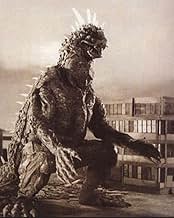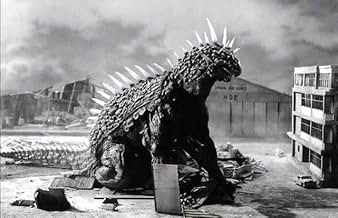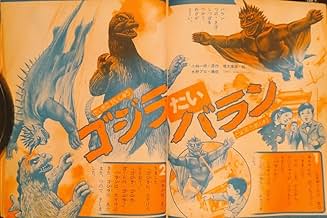Daikaijû Baran
- 1958
- 1 घं 27 मि
IMDb रेटिंग
5.3/10
1 हज़ार
आपकी रेटिंग
अपनी भाषा में प्लॉट जोड़ेंOriginal Japanese version. Research in the Tohoku region comes across a monster known to the locals as the mountain god Baradagi.Original Japanese version. Research in the Tohoku region comes across a monster known to the locals as the mountain god Baradagi.Original Japanese version. Research in the Tohoku region comes across a monster known to the locals as the mountain god Baradagi.
- निर्देशक
- लेखक
- स्टार
फ़ीचर्ड समीक्षाएं
Scientists discover a species of butterfly that is believed to be native only to Siberia. They travel to a region known as "The Tibet of Japan", where a much bigger menace awaits: the towering lizard "Varan", some sort of throwback. Varan, of course, turns out to be a huge threat, but Japanese military forces are hard pressed to find a plan of attack that actually works.
Ultimately, "Varan the Unbelievable" is too much of an unimaginative "Gojira" clone to be all that successful. The action is decent, and the special effects are decent (some of the time, anyway). The atmosphere and widescreen photography are certainly reasonably impressive. But the characters lack any sort of truly interesting features; they're not fleshed out much at all. The steadfast actors do what they can with the material: Kozo Nomura as jut jawed, heroic Kenji, Ayumi Sonoda as his love interest Yuriko, a headstrong reporter, and Koreya Senda as the knowledgeable Dr. Sugimoto. The music by Akira Ifukube is rousing enough to be entertaining.
But Varan itself, while an engaging monster to watch for 87 minutes, lacks the appeal of the most striking creatures in Japanese genre cinema.
Not one of director Ishiro Hondas' best efforts, but lightly entertaining.
Six out of 10.
Ultimately, "Varan the Unbelievable" is too much of an unimaginative "Gojira" clone to be all that successful. The action is decent, and the special effects are decent (some of the time, anyway). The atmosphere and widescreen photography are certainly reasonably impressive. But the characters lack any sort of truly interesting features; they're not fleshed out much at all. The steadfast actors do what they can with the material: Kozo Nomura as jut jawed, heroic Kenji, Ayumi Sonoda as his love interest Yuriko, a headstrong reporter, and Koreya Senda as the knowledgeable Dr. Sugimoto. The music by Akira Ifukube is rousing enough to be entertaining.
But Varan itself, while an engaging monster to watch for 87 minutes, lacks the appeal of the most striking creatures in Japanese genre cinema.
Not one of director Ishiro Hondas' best efforts, but lightly entertaining.
Six out of 10.
Toho's 1958 "Varan the Unbelievable" (Daikaiju Baran or Giant Monster Varan) remained unseen in the US until the 2000s, only known by its Crown International release of 1962. Baradagi was its name among the superstitious locals in Iwaya Village in the mountainous region of Siberia where a rare species of butterfly has been discovered, two investigators perishing in an avalanche. Three more follow up to find some answers and are told by the high priest that their god does not like intruders, but a runaway dog ensures its emergence from a large lake to run amok for a brief period. A military bombardment causes Varan to spread out its webbed claws and arms to glide like a flying squirrel toward the ocean (never shown in the Crown edit), where it simply swims through a continued barrage that has little effect on it. Only after Varan comes ashore to indulge its fascination for parachuting light bombs do authorities arrive at a solution, a special mixture of explosive gunpowder that should detonate once the monster swallows it, similar to the sorry fate of "Yongary Monster from the Deep" (not to be viewed when suffering indigestion!). Intended as a television coproduction between Toho and Hollywood's AB-PT (American Broadcasting-Paramount Theatres), the latter went belly up right after their initial double bill release, Bert I. Gordon's "Beginning of the End" and John Carradine's "The Unearthly," leaving undaunted director Ishiro Honda to forge ahead with his usual crew, though on a noticeably lower budget in black and white with the most basic outline ever conceived for a kaiju film, Akihiko Hirata and Yoshio Tsuchiya the only familiar faces and little comic relief. The original version did receive theatrical distribution in Japan, and once Varan rises from his watery slumber there's plenty of monster footage to maintain interest (his first appearance at the 12 minute mark, much sooner than in Crown's retread), so even if it's a relatively minor cousin to Godzilla, and only a glider compared to Rodan's wingspan, it still proves how much better Toho was over their Hollywood counterparts (Varan would not be forgotten, as noted by its brief presence ten years later in "Destroy All Monsters"). What the 1958 original is now best known for is a stirring score by Akira Ifukube that could have been lost in time were it not revived to excellent effect in future Godzilla entries. It boggles the mind when Crown International jettisoned so much usable footage to offer up a tiny portion of what should have been more of a banquet, beefing up the starring role for little known Myron Healey at the expense of virtually everything else for its eventual stateside release in 1962, a successful pairing with "First Spaceship on Venus."
Of all the kaijyu movies Toho has produced in the '50s, this probably is the least well known. It was originally available in United States in a super 8 format under the title "Varan the Unbelievable", and sported American actors. The one reviewed here is not this Americanized version but the original Japanese version called "Daikaijyu Baran" (Literal translation: Giant monster Baran). Being a kaijyu eiga fan, I used to hear about this monster a lot and wished I could find a copy for a long time. I'm happy that it is now available on DVD.
Baran gets its inspiration from Japanese flying squirrel called musasabi and it was intended to be a flying monster from the start. What makes this movie little weak is the lack of character of the monster itself. In most Japanese kaijyu movie, there's a subplot that justifies the character of the monster, but in this movie this is lacking. He's supposed to be some sort of god to the village people, but when he shows up, he's just a giant reptile out for destruction.
This is a cult classic kaijyu movie, and definitely worth a watch before it disappears into obscurity again.
Baran gets its inspiration from Japanese flying squirrel called musasabi and it was intended to be a flying monster from the start. What makes this movie little weak is the lack of character of the monster itself. In most Japanese kaijyu movie, there's a subplot that justifies the character of the monster, but in this movie this is lacking. He's supposed to be some sort of god to the village people, but when he shows up, he's just a giant reptile out for destruction.
This is a cult classic kaijyu movie, and definitely worth a watch before it disappears into obscurity again.
One of the better of the early Toho monster epics, the film suffers from a lack of definition. We don't really know where this monster comes from, or why he's so pee-ed off he wants to stomp Tokyo. Also, he never even quite gets to Tokyo, which is major disappointment - what good is a Japanese monster movie where Tokyo doesn't get stomped.
I suspect that the secret to this problem lies in the original score for the film, by the great Akira Ifikube. Godzilla fans should recognize variations on three essential themes for other movies - for "Godzilla", "Rodan", and "Mothra". Yet they are not just borrowed sound-tracks from those films, but actual variations. Apparently Ifikube used composition for this film as a kind of notebook on themes that would later get improved on again and again. My sense is that this is true of the film as a whole, that director Honda and crew used this film as a test-case for work on later films - the kaiju film industry was about to go wide-screen and technicolor in a big way, but the exact formula for the genre had not yet come together. I think they were using this film to get it together.
In its favor, I remark the film is narratively tight, so that not much time is wasted on the back-stories. It is what it is, a straight-out rubber-monster stomp, and begs to be enjoyed for that, and nothing more.
By the way, the subtitled DVD release from Animego has a couple fascinating bonuses to it - an interview with one of the special fx crew, as well as a demonstration of the technique used to manufacture the monster's costume. The film itself is enjoyable, if no great shakes, but bits of film-history like this are priceless.
I suspect that the secret to this problem lies in the original score for the film, by the great Akira Ifikube. Godzilla fans should recognize variations on three essential themes for other movies - for "Godzilla", "Rodan", and "Mothra". Yet they are not just borrowed sound-tracks from those films, but actual variations. Apparently Ifikube used composition for this film as a kind of notebook on themes that would later get improved on again and again. My sense is that this is true of the film as a whole, that director Honda and crew used this film as a test-case for work on later films - the kaiju film industry was about to go wide-screen and technicolor in a big way, but the exact formula for the genre had not yet come together. I think they were using this film to get it together.
In its favor, I remark the film is narratively tight, so that not much time is wasted on the back-stories. It is what it is, a straight-out rubber-monster stomp, and begs to be enjoyed for that, and nothing more.
By the way, the subtitled DVD release from Animego has a couple fascinating bonuses to it - an interview with one of the special fx crew, as well as a demonstration of the technique used to manufacture the monster's costume. The film itself is enjoyable, if no great shakes, but bits of film-history like this are priceless.
I think this was Toho's fourth "giant monster on the loose" movie, and it's also probably the least known. The American "version", "Varan the Unbelievable", is a travesty and should be avoided at all costs.
The Japanese original has some really good things about it. It features one of Akira Ifukube's best monster-movie scores, in which he introduced some themes that would be re-used in practically every kaiju eiga that followed... There's also a wonderful "Lovecraft-gone-Japanese" feeling about the protagonists' arrival in the village: they interrupt a strange ceremony, and a sea of masked faces turns to watch them. This is followed by an eerie scene as they follow a mist-shrouded path to the forbidden lake.
Unfortunately, the rest of the movie is a little uninspired. It doesn't have the emotional tension of "Godzilla" or "Rodan", although the monster costume and attack scenes are very, very good.
The Japanese original has some really good things about it. It features one of Akira Ifukube's best monster-movie scores, in which he introduced some themes that would be re-used in practically every kaiju eiga that followed... There's also a wonderful "Lovecraft-gone-Japanese" feeling about the protagonists' arrival in the village: they interrupt a strange ceremony, and a sea of masked faces turns to watch them. This is followed by an eerie scene as they follow a mist-shrouded path to the forbidden lake.
Unfortunately, the rest of the movie is a little uninspired. It doesn't have the emotional tension of "Godzilla" or "Rodan", although the monster costume and attack scenes are very, very good.
क्या आपको पता है
- ट्रिवियाThis film began as a direct-to-television co-production between AB-PT and Toho, and thus was shot in black and white in the Academy aspect ratio. AB-PT went bankrupt during production, but a two-part TV film was still completed. The two parts were then edited into a single, longer feature film to be shown in Japanese theaters, which involved extending and re-recording the musical score, shortening scenes and adding new ones. This theatrical feature was then cropped shot by shot and released in an ersatz anamorphic widescreen format apparently adapted from SuperScope called TohoPanScope. Neither the TV version nor the theatrical version of this film exist in the Academy ratio, but the fully mixed audio track for the TV version still exists as of this date.
- गूफ़Several short clips of Varan's attack on Tokyo are actually stock footage from गॉडज़िला (1954), including a shot of Godzilla's tail smashing into a building and a POV shot from inside a warehouse of Godzilla's foot caving the structure in. Similarly, Varan's roar is an amalgamation of various Toho giant monster roars, including that of Godzilla himself.
- इसके अलावा अन्य वर्जनThe scene of Baran (aka Varan) flying is deleted from the American version of the film.
- कनेक्शनEdited into Varan the Unbelievable (1962)
टॉप पसंद
रेटिंग देने के लिए साइन-इन करें और वैयक्तिकृत सुझावों के लिए वॉचलिस्ट करें
- How long is Varan?Alexa द्वारा संचालित
विवरण
- रिलीज़ की तारीख़
- कंट्री ऑफ़ ओरिजिन
- भाषा
- इस रूप में भी जाना जाता है
- Baran: Monster from the East
- फ़िल्माने की जगहें
- उत्पादन कंपनी
- IMDbPro पर और कंपनी क्रेडिट देखें
- चलने की अवधि
- 1 घं 27 मि(87 min)
- रंग
- ध्वनि मिश्रण
- पक्ष अनुपात
- 2.00 : 1
इस पेज में योगदान दें
किसी बदलाव का सुझाव दें या अनुपलब्ध कॉन्टेंट जोड़ें














